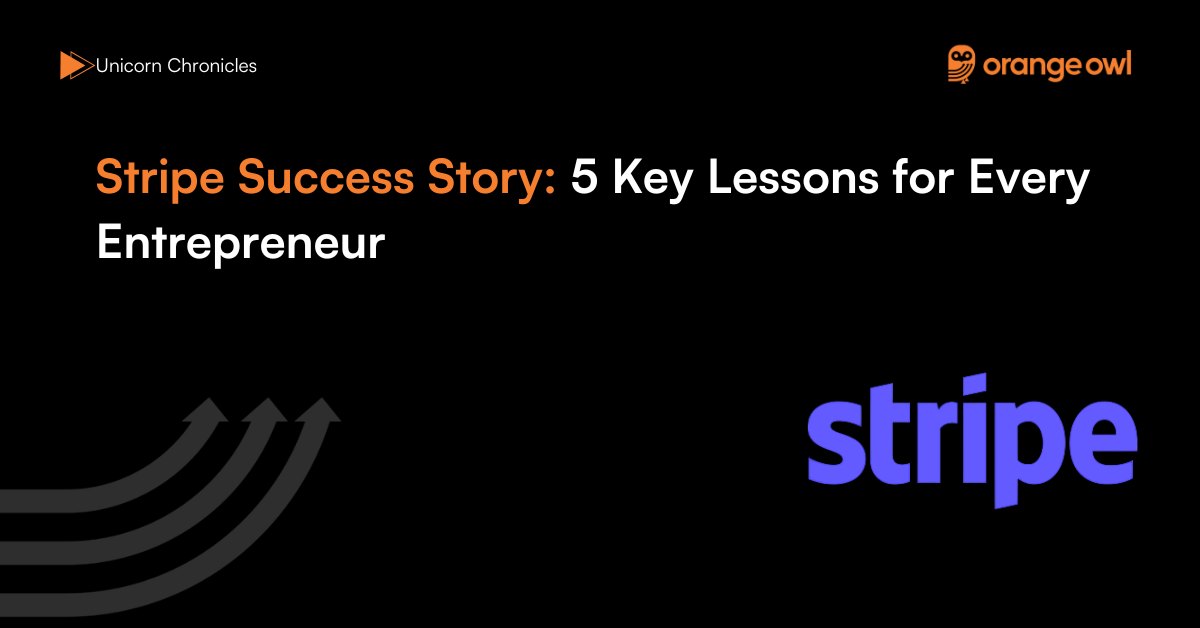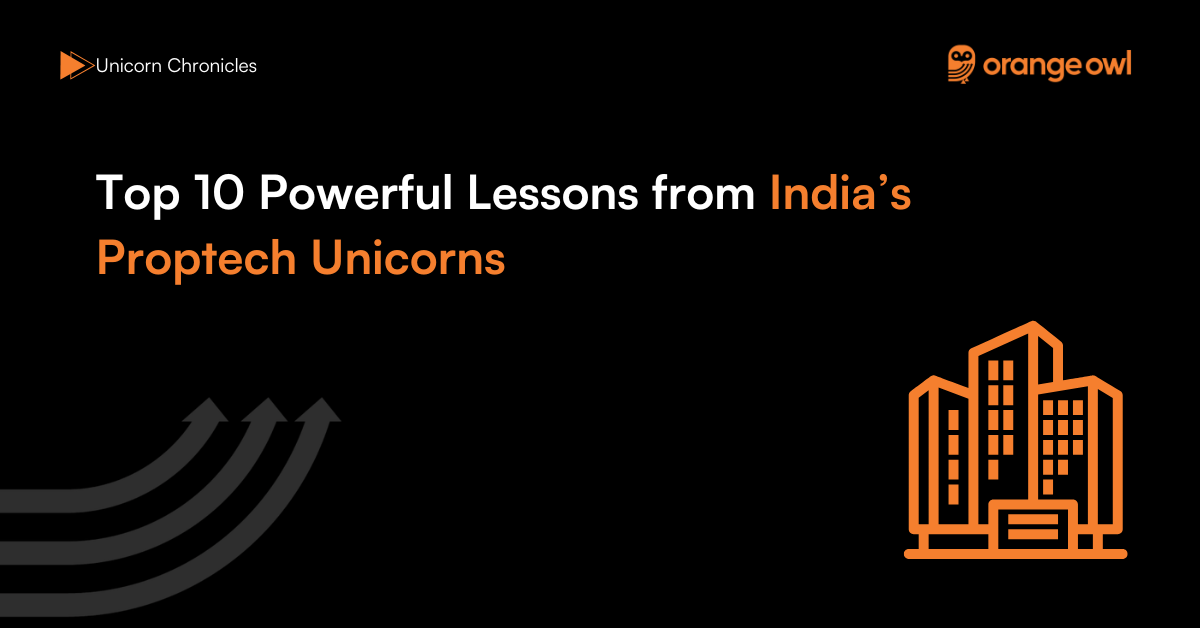The Ultimate Outbound Marketing Guide: Strategies, Tips, and Case Studies
Vivek Goel
July 8, 2024
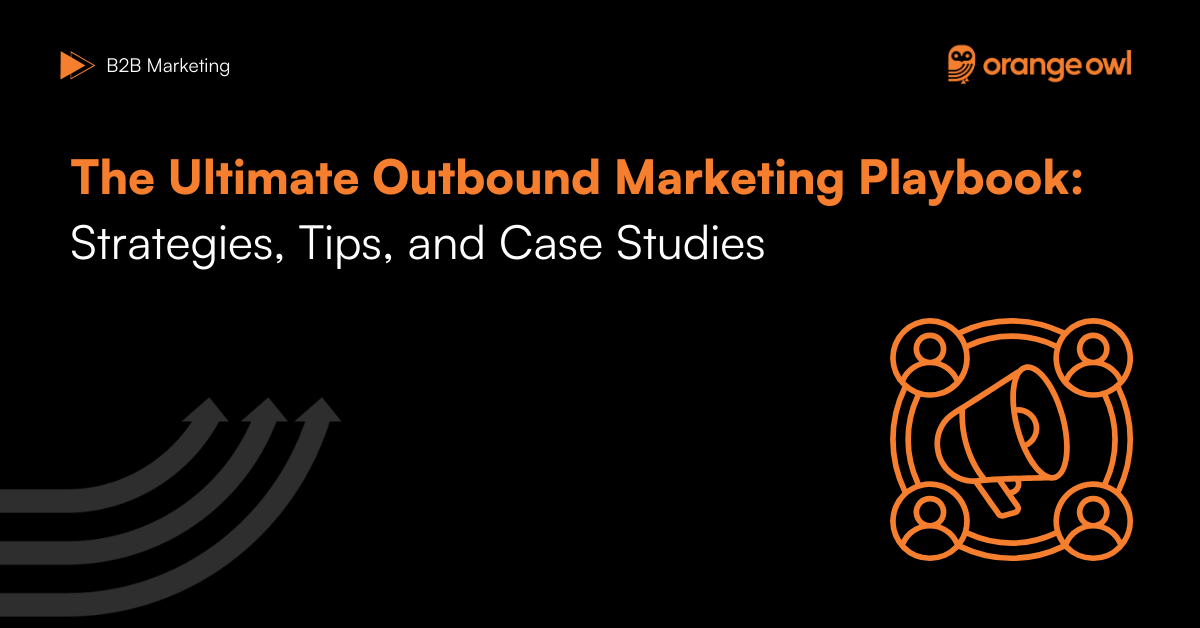
Table of Contents
Introduction
When combined with a well-crafted Go-to-Market (GTM) strategy, outbound marketing can significantly enhance a company’s market presence and drive growth. This ultimate outbound marketing guide covers everything you need to know about outbound marketing, from its definition and core principles to implementation strategies and best practices.
What is Outbound Marketing?
Outbound marketing refers to any kind of marketing where a company initiates the conversation and sends its message out to an audience. This form of marketing includes traditional methods like TV and radio ads, print advertisements, cold calling, direct mail, and more recently, digital tactics such as display ads and email marketing.
B2B Example: A B2B software company might use outbound marketing by purchasing ad space in industry-specific magazines or by sending targeted emails to decision-makers in potential client companies.
How is Outbound Marketing different from Inbound Marketing?
Inbound marketing focuses on attracting customers through valuable content and interactions initiated by the customer, whereas outbound marketing involves actively reaching out to potential customers through various advertising and direct marketing tactics.
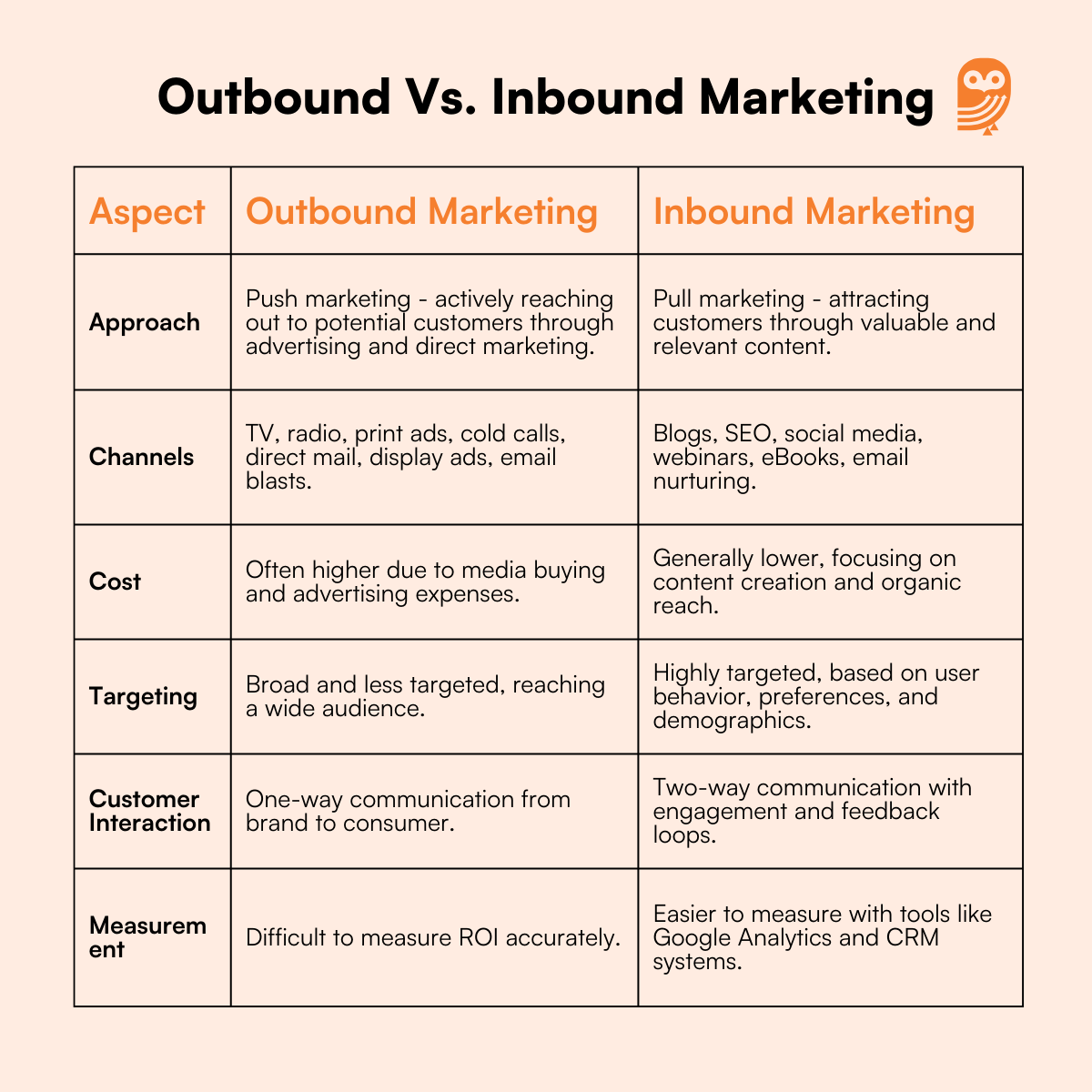
The Core Principles of Outbound Marketing
Outbound marketing is built on several key principles, including reach, interruption, and frequency. These principles guide every outbound campaign.
1. Reach
The goal of outbound marketing is to reach a large number of people quickly. This can be achieved through various channels like TV, radio, print, and digital advertising.
Key Tactics:
- Mass Media Advertising: Utilizing TV, radio, and print to broadcast messages to a wide audience.
- Direct Mail: Sending promotional materials directly to potential customers’ mailboxes.
- Cold Calling: Reaching out to potential customers via phone calls.
B2B Example: A logistics company might run ads in trade publications and industry websites to reach procurement managers and decision-makers.
Expert Tips:
- Identify the media channels that your target audience frequently uses.
- Allocate your budget to channels that offer the best ROI.
- Use tracking mechanisms like custom URLs or unique discount codes to measure effectiveness.
Actionable Steps:
- Conduct market research to identify the most effective channels for your target audience.
- Develop a media plan that outlines your budget, channels, and frequency of ads.
- Implement tracking tools to measure the performance of your outbound campaigns.
2. Interruption
Outbound marketing often involves interrupting the audience to get their attention. This is achieved through compelling messages and creative advertising techniques.
Key Tactics:
- Compelling Advertisements: Creating eye-catching and memorable ads that capture attention.
- Promotions and Offers: Using special offers and discounts to entice the audience.
- Events and Trade Shows: Participating in industry events to showcase products and services.
B2B Example: A manufacturing company might send direct mail with a special discount offer to procurement managers to encourage them to try their products.
Expert Tips:
- Use strong visuals and headlines to capture attention quickly.
- Ensure your message is clear and concise to communicate the value proposition effectively.
- Test different ad creatives and offers to see what resonates best with your audience.
Actionable Steps:
- Develop compelling ad creatives that capture attention and communicate your message.
- Create special offers or promotions to encourage immediate action.
- Test different ad variations to determine the most effective approach.
3. Frequency
Repetition is key in outbound marketing. Frequent exposure to your message increases the likelihood of audience recall and response.
Key Tactics:
- Consistent Advertising: Running ads frequently across chosen channels.
- Remarketing: Using digital ads to target individuals who have previously interacted with your brand.
- Follow-up Campaigns: Conducting follow-up campaigns to reinforce the initial message.
B2B Example: A SaaS company might run a series of email campaigns to nurture leads and keep their brand top-of-mind.
Expert Tips:
- Plan your ad schedule to ensure consistent and repeated exposure.
- Use remarketing tactics to re-engage potential customers who have shown interest.
- Monitor the frequency of your ads to avoid ad fatigue.
Actionable Steps:
- Develop a campaign schedule that ensures consistent ad exposure.
- Implement remarketing strategies using platforms like Google Ads or Facebook Ads.
- Regularly review ad performance and adjust frequency to optimize results.
The Outbound Marketing Funnel
The outbound marketing funnel represents the stages a prospect goes through from initial awareness to becoming a customer. It consists of four stages: Awareness, Interest, Decision, and Action.
1. Awareness Stage
In the awareness stage, potential customers first become aware of your brand through outbound marketing efforts. The goal is to reach as many people as possible and create brand recognition.
Types of Content:
- TV and radio ads
- Print advertisements
- Display ads
B2B Example: A B2B company might place display ads on industry websites and sponsor industry-specific webinars to increase brand awareness among decision-makers.
Expert Tips:
- Use high-impact visuals and messages to capture attention quickly.
- Ensure your branding is consistent across all channels.
- Utilize geo-targeting and demographic targeting to reach the right audience.
Actionable Steps:
- Develop high-impact ads that quickly capture attention and convey your brand message.
- Place ads on channels frequented by your target audience.
- Track brand awareness metrics, such as ad recall and brand recognition, to measure effectiveness.
2. Interest Stage
During the interest stage, prospects start to show interest in your products or services. Your goal is to provide more information and keep them engaged.
Types of Content:
- Email campaigns
- Direct mail
- Webinars
B2B Example: A consulting firm might send targeted email campaigns with case studies and industry insights to decision-makers who have shown interest.
Expert Tips:
- Use educational content to address common pain points and provide value.
- Personalize your communications to make them more relevant and engaging.
- Include clear calls-to-action to guide prospects to the next step.
Actionable Steps:
- Develop email campaigns and direct mail materials that provide valuable information and insights.
- Personalize your communications based on the recipient’s industry and interests.
- Include clear and compelling calls-to-action in all your communications.
3. Decision Stage
In the decision stage, prospects are evaluating their options and deciding whether to choose your product or service. Your goal is to provide compelling reasons to choose your brand.
Types of Content:
- Product demos
- Free trials
- Sales presentations
B2B Example: A technology company might offer free trials of their software and conduct personalized sales presentations to address specific client needs.
Expert Tips:
- Highlight your unique selling propositions (USPs) and how they benefit the prospect.
- Provide testimonials and case studies to build credibility and trust.
- Offer free trials or demos to allow prospects to experience your product firsthand.
Actionable Steps:
- Develop product demos and free trial offers that showcase the benefits of your product.
- Use testimonials and case studies to build credibility and trust.
- Conduct personalized sales presentations to address specific client needs and concerns.
4. Action Stage
In the action stage, prospects make the decision to purchase your product or service. Your goal is to facilitate the purchase process and close the sale.
Types of Content:
- Purchase incentives
- Detailed proposals
- Follow-up calls
B2B Example: A professional services firm might provide detailed proposals and follow-up calls to close deals with potential clients.
Expert Tips:
- Make the purchase process as simple and straightforward as possible.
- Offer purchase incentives, such as discounts or bonuses, to encourage immediate action.
- Follow up promptly with prospects to address any remaining questions or concerns.
Actionable Steps:
- Develop detailed proposals and follow-up plans to close deals with potential clients.
- Offer purchase incentives to encourage immediate action.
- Follow up promptly with prospects to address any remaining questions or concerns.
Implementing an Outbound Marketing Strategy
Implementing an outbound marketing strategy requires careful planning and execution. Here are the steps to create a successful outbound marketing strategy:
1. Define Your Goals
Start by setting clear, measurable goals for your outbound marketing efforts. These goals should align with your overall business objectives.
Examples:
- Increase brand awareness by 25% in six months.
- Generate 100 new leads per month.
- Increase sales by 20% in the next quarter.
Expert Tips:
- Use the SMART criteria (Specific, Measurable, Achievable, Relevant, Time-bound) to set your goals.
- Regularly review and adjust your goals based on performance data.
- Communicate your goals to your team to ensure everyone is aligned.
Actionable Steps:
- Define your outbound marketing goals using the SMART criteria.
- Set up analytics tools to track your progress toward these goals.
- Review your goals quarterly and make adjustments as needed.
2. Identify Your Target Audience
Understanding your target audience is crucial for outbound marketing. Identify the demographics, behaviors, and preferences of your ideal customers.
Target Audience Components:
- Demographic information
- Job role and company details
- Goals and challenges
- Interests and behaviors
B2B Example: A B2B marketing agency might target marketing managers and directors in mid-sized technology companies.
Expert Tips:
- Use market research and customer data to identify your target audience.
- Create detailed buyer personas to understand your audience’s needs and preferences.
- Segment your audience based on demographics, behavior, and interests.
Actionable Steps:
- Conduct market research to identify your target audience.
- Develop detailed buyer personas based on research and data.
- Segment your audience to tailor your outbound marketing efforts.
3. Develop a Marketing Message
Craft a compelling marketing message that resonates with your target audience. Your message should clearly communicate the value of your product or service.
Marketing Message Components:
- Value proposition
- Key benefits
- Unique selling points (USPs)
- Call-to-action (CTA)
B2B Example: A cybersecurity company might emphasize the importance of protecting sensitive data and highlight their unique features that differentiate them from competitors.
Expert Tips:
- Focus on the benefits and value your product or service offers.
- Use clear and concise language to communicate your message.
- Include a strong call-to-action to encourage immediate response.
Actionable Steps:
- Develop a marketing message that clearly communicates the value of your product or service.
- Highlight your unique selling points and key benefits.
- Include a strong call-to-action in all your marketing materials.
4. Choose the Right Channels
Select the most effective channels for reaching your target audience. Consider a mix of traditional and digital channels to maximize reach and engagement.
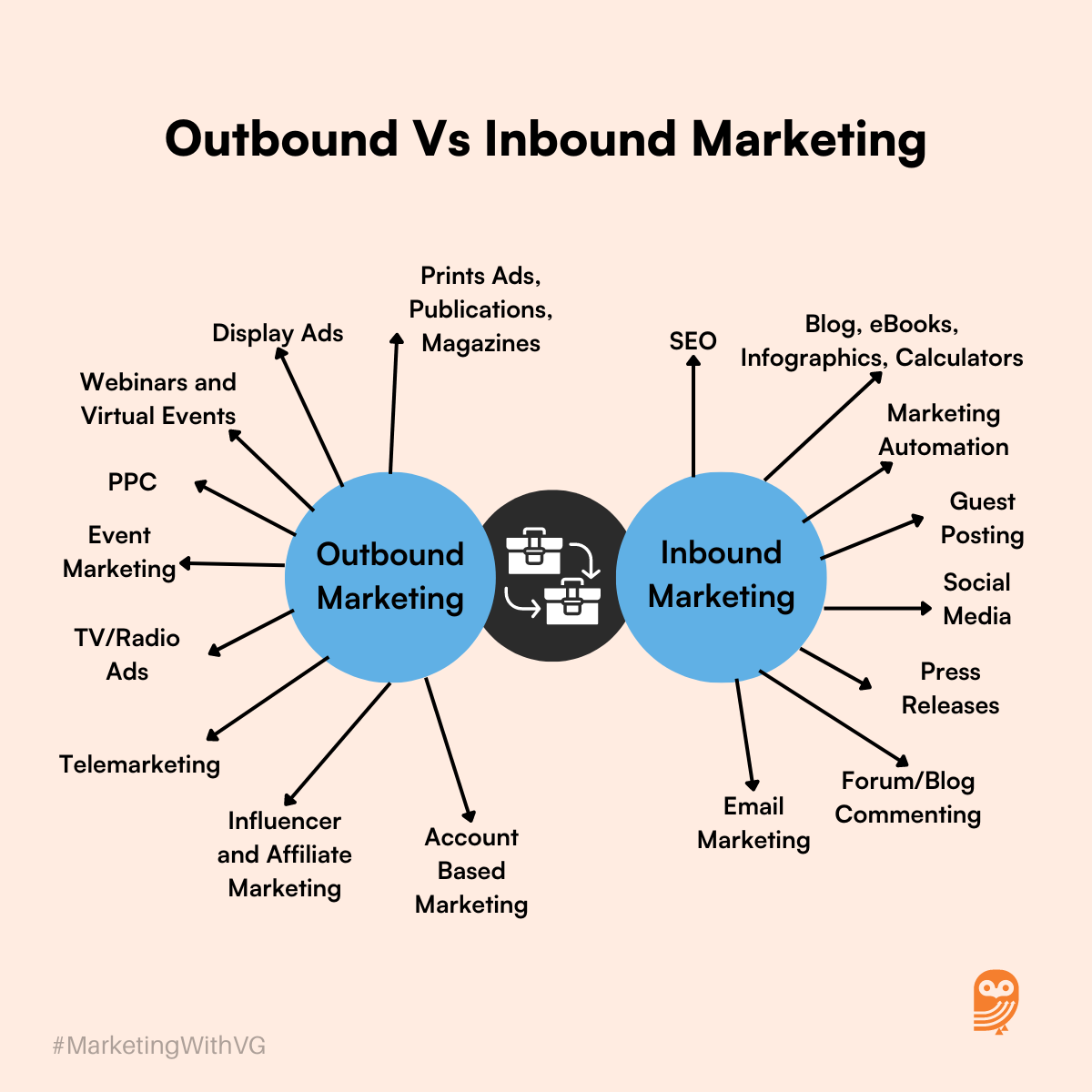
Outbound Marketing Channels:
- TV and radio advertising
- Print advertising
- Direct mail
- Cold calling
- Email marketing
- Display advertising
B2B Example: A software company might use a combination of email marketing, display advertising, and sponsored content on industry websites.
Expert Tips:
- Choose channels that your target audience frequently uses.
- Allocate your budget to channels that offer the best ROI.
- Test different channels and adjust your strategy based on performance data.
Actionable Steps:
- Identify the most effective channels for reaching your target audience.
- Develop a media plan that outlines your budget, channels, and frequency of ads.
- Test different channels and adjust your strategy based on performance data.
5. Create Compelling Content
Develop compelling content that captures attention and communicates your message. Use a mix of formats to engage your audience.
Types of Content:
- Advertisements (TV, radio, print, digital)
- Direct mail pieces
- Email campaigns
- Product demos
- Case studies
- Webinars
B2B Example: A B2B financial services firm might create a series of informative webinars and email campaigns to engage potential clients.
Expert Tips:
- Use high-quality visuals and compelling copy to capture attention.
- Personalize your content to make it more relevant and engaging.
- Test different content formats to see what resonates best with your audience.
Actionable Steps:
- Develop a variety of content formats to engage your audience.
- Use high-quality visuals and compelling copy to capture attention.
- Test different content formats to determine the most effective approach.
6. Implement Tracking and Analytics
Use tracking and analytics tools to measure the performance of your outbound marketing efforts. Regularly review your data to optimize your strategy.
Key Metrics to Track:
- Reach and impressions
- Lead generation
- Conversion rates
- Return on investment (ROI)
- Customer acquisition cost (CAC)
B2B Example: A B2B software company might track metrics such as lead generation, conversion rates, and ROI to evaluate the effectiveness of their outbound marketing campaigns.
Expert Tips:
- Use tracking tools like Google Analytics, HubSpot, or Salesforce to monitor your performance.
- Regularly review your data to identify trends and patterns.
- Make data-driven decisions to optimize your outbound marketing strategy.
Actionable Steps:
- Set up tracking tools to monitor your outbound marketing metrics.
- Create regular reports to review your performance and identify areas for improvement.
- Use A/B testing and other optimization techniques to improve your results.
7. Integrate with Inbound Marketing
Integrate your outbound marketing efforts with your inbound marketing strategy to create a cohesive and effective marketing approach.
Integration Tactics:
- Use outbound methods to promote inbound content (e.g., advertise a webinar on social media).
- Leverage inbound data to inform outbound campaigns (e.g., target email lists based on website behavior).
- Combine inbound and outbound tactics for lead nurturing (e.g., follow up on a cold call with an email campaign).
B2B Example: A B2B consulting firm might use outbound email campaigns to drive traffic to their blog, where they offer valuable insights and resources.
Expert Tips:
- Ensure your messaging is consistent across inbound and outbound channels.
- Use data from your inbound efforts to inform your outbound strategy.
- Create a seamless experience for your audience by integrating your marketing tactics.
Actionable Steps:
- Develop a plan to integrate your inbound and outbound marketing efforts.
- Use data from your inbound marketing to inform your outbound campaigns.
- Ensure your messaging is consistent across all channels.
Tools and Platforms for Outbound Marketing
A variety of tools and platforms can help you implement and manage your outbound marketing strategy effectively.
1. Customer Relationship Management (CRM) Systems
CRM systems help you manage your interactions with current and potential customers. Popular options include:
- Salesforce
- HubSpot CRM
- Zoho CRM
Expert Tips:
- Choose a CRM system that integrates with your existing tools and systems.
- Use CRM data to personalize your outbound marketing efforts.
- Regularly update your CRM to ensure accurate and up-to-date information.
Actionable Steps:
- Select a CRM system that meets your needs and budget.
- Set up your CRM and import your customer data.
- Use CRM data to personalize and optimize your outbound marketing efforts.
2. Email Marketing Platforms
Email marketing platforms help you create and manage email campaigns. Popular options include:
Expert Tips:
- Use email marketing software to segment your list and automate campaigns.
- Personalize your emails based on the recipient’s industry and interests.
- Use A/B testing to optimize your email campaigns.
Actionable Steps:
- Select an email marketing platform that meets your needs and budget.
- Set up your email list and segment it based on demographics and behavior.
- Create and send targeted email campaigns to your audience.
3. Advertising Platforms
Advertising platforms help you reach your target audience through various channels. Popular options include:
Expert Tips:
- Choose advertising platforms that your target audience frequently uses.
- Use targeting options to reach the right audience with your ads.
- Regularly review and optimize your ad campaigns based on performance data.
Actionable Steps:
- Identify the most effective advertising platforms for your target audience.
- Develop ad campaigns that capture attention and communicate your message.
- Use targeting options to reach the right audience with your ads.
4. Direct Mail Platforms
Direct mail platforms help you create and send physical mail to potential customers. Popular options include:
Expert Tips:
- Use direct mail to complement your digital marketing efforts.
- Personalize your direct mail pieces to make them more relevant and engaging.
- Track the performance of your direct mail campaigns to measure effectiveness.
Actionable Steps:
- Select a direct mail platform that meets your needs and budget.
- Develop personalized direct mail pieces that capture attention.
- Track the performance of your direct mail campaigns to measure effectiveness.
Case Studies and Success Stories
Examining real-life examples of successful outbound marketing campaigns can provide valuable insights and inspiration for your strategy.
Case Study 1: IBM’s Email Marketing Campaign
IBM used targeted email campaigns to reach decision-makers in specific industries. By personalizing their emails and offering valuable resources, they were able to generate high-quality leads and increase conversions.
Key Takeaways:
- Use personalized email campaigns to engage your audience.
- Offer valuable resources to generate leads.
- Track and optimize your email campaigns for better results.
Case Study 2: GE’s TV Advertising Campaign
General Electric (GE) used TV advertising to showcase their innovative products and solutions. By creating compelling ads that highlighted their unique value proposition, they were able to increase brand awareness and drive sales.
Key Takeaways:
- Use high-impact visuals and compelling messages to capture attention.
- Highlight your unique value proposition in your ads.
- Use TV advertising to reach a large and diverse audience.
Case Study 3: Salesforce’s Direct Mail Campaign
Salesforce used direct mail to reach potential customers with personalized offers and invitations to events. By integrating direct mail with their digital marketing efforts, they were able to create a cohesive and effective marketing strategy.
Key Takeaways:
- Use direct mail to complement your digital marketing efforts.
- Personalize your direct mail pieces to make them more relevant and engaging.
- Integrate direct mail with your other marketing tactics for a cohesive strategy.
Challenges and Solutions in Outbound Marketing
While outbound marketing offers many benefits, it also comes with its own set of challenges. Here are some common challenges and solutions:
1. High Costs
Challenge: Outbound marketing methods, such as TV advertising and direct mail, can be expensive.
Solution: Optimize your budget by focusing on the most effective channels and tactics. Use tracking and analytics to measure ROI and make data-driven decisions.
Expert Tips:
- Use cost-effective channels, such as email marketing and digital advertising.
- Regularly review your budget and allocate funds to the most effective tactics.
- Negotiate with media vendors to get the best rates for advertising.
Actionable Steps:
- Identify the most cost-effective channels for your outbound marketing efforts.
- Develop a budget that focuses on the most effective tactics.
- Use tracking and analytics to measure ROI and optimize your budget.
2. Difficulty in Measuring ROI
Challenge: Measuring the ROI of outbound marketing efforts can be complex.
Solution: Use tracking tools and methods, such as unique URLs, discount codes, and CRM systems, to measure the performance of your outbound campaigns.
Expert Tips:
- Use unique URLs and discount codes to track the performance of your ads.
- Integrate your outbound marketing efforts with your CRM system to measure results.
- Regularly review your ROI metrics and make data-driven decisions.
Actionable Steps:
- Set up tracking tools to measure the performance of your outbound campaigns.
- Use unique URLs and discount codes to track the effectiveness of your ads.
- Integrate your outbound marketing efforts with your CRM system to measure results.
3. Ad Fatigue
Challenge: Frequent exposure to the same ads can lead to ad fatigue, where the audience becomes less responsive to your messages.
Solution: Rotate your ad creatives and vary your messaging to keep your audience engaged. Use A/B testing to determine the most effective ad variations.
Expert Tips:
- Rotate your ad creatives regularly to keep your audience engaged.
- Use A/B testing to determine the most effective ad variations.
- Monitor ad performance and adjust your strategy based on the data.
Actionable Steps:
- Develop a variety of ad creatives to rotate regularly.
- Use A/B testing to determine the most effective ad variations.
- Monitor ad performance and adjust your strategy based on the data.
4. Audience Targeting
Challenge: Reaching the right audience with your outbound marketing efforts can be challenging.
Solution: Use data and analytics to identify and segment your target audience. Leverage targeting options available on digital advertising platforms to reach the right people.
Expert Tips:
- Use market research and customer data to identify your target audience.
- Segment your audience based on demographics, behavior, and interests.
- Use targeting options available on digital advertising platforms to reach the right people.
Actionable Steps:
- Conduct market research to identify your target audience.
- Develop detailed buyer personas based on research and data.
- Use targeting options available on digital advertising platforms to reach the right people.
5. Integration with Inbound Marketing
Challenge: Integrating outbound and inbound marketing efforts can be complex.
Solution: Develop a cohesive marketing strategy that combines both outbound and inbound tactics. Use data and analytics to inform your strategy and ensure consistency across channels.
Expert Tips:
- Ensure your messaging is consistent across inbound and outbound channels.
- Use data from your inbound efforts to inform your outbound strategy.
- Create a seamless experience for your audience by integrating your marketing tactics.
Actionable Steps:
- Develop a plan to integrate your inbound and outbound marketing efforts.
- Use data from your inbound marketing to inform your outbound campaigns.
- Ensure your messaging is consistent across all channels.
Future Trends in Outbound Marketing
Outbound marketing is constantly evolving, and staying ahead of the latest trends can help you maintain a competitive edge. Here are some future trends to watch:
1. Advanced Targeting and Personalization
Advancements in data and technology are enabling more precise targeting and personalization in outbound marketing. Marketers can now use advanced data analytics and machine learning to deliver highly personalized and relevant messages to their audience.
Example: Use data from CRM systems and digital behavior to create personalized direct mail campaigns.
Expert Tips:
- Leverage advanced data analytics to identify and segment your audience.
- Use machine learning algorithms to deliver personalized messages at scale.
- Regularly review and optimize your targeting and personalization efforts.
Actionable Steps:
- Implement advanced data analytics tools to identify and segment your audience.
- Use machine learning algorithms to deliver personalized messages at scale.
- Regularly review and optimize your targeting and personalization efforts.
2. Integration with Digital Channels
Integrating outbound marketing with digital channels is becoming increasingly important. Marketers can use digital advertising, social media, and email marketing to complement traditional outbound tactics and create a cohesive strategy.
Example: Use digital advertising to promote direct mail campaigns and track engagement.
Expert Tips:
- Integrate your outbound marketing efforts with digital channels for a cohesive strategy.
- Use digital advertising to complement traditional outbound tactics.
- Track and measure the performance of your integrated campaigns.
Actionable Steps:
- Develop a plan to integrate your outbound marketing efforts with digital channels.
- Use digital advertising to complement traditional outbound tactics.
- Track and measure the performance of your integrated campaigns.
3. Interactive and Immersive Experiences
Interactive and immersive experiences, such as augmented reality (AR) and virtual reality (VR), are becoming popular in outbound marketing. These technologies can create engaging and memorable experiences for your audience.
Example: Use AR to create interactive direct mail pieces that come to life when viewed through a mobile device.
Expert Tips:
- Explore the use of AR and VR to create interactive and immersive experiences.
- Use interactive content to engage your audience and create memorable experiences.
- Track the performance of your interactive campaigns to measure effectiveness.
Actionable Steps:
- Explore the use of AR and VR to create interactive and immersive experiences.
- Develop interactive content to engage your audience and create memorable experiences.
- Track the performance of your interactive campaigns to measure effectiveness.
Conclusion
Outbound marketing remains a powerful strategy for reaching, engaging, and converting potential customers. By understanding the core principles, implementing a well-defined strategy, and leveraging the right tools and platforms, you can achieve significant results and grow your business.
As the marketing landscape continues to evolve, staying ahead of the latest trends and best practices in outbound marketing will help you maintain a competitive edge and continue to deliver value to your audience.
By continually refining your outbound marketing efforts and staying attuned to the needs of your audience, you can build lasting relationships and drive long-term success for your business.
Top Frequently Asked Questions (FAQs) on Outbound Marketing
Yes, outbound marketing remains effective, especially when integrated with digital marketing strategies. It can quickly create awareness and reach a large audience, which can then be nurtured through inbound techniques.
Small businesses can leverage cost-effective outbound marketing methods like email marketing, direct mail, and targeted digital advertising to reach potential customers. Combining these with personalized offers and compelling messaging can enhance effectiveness.
Common mistakes include:
- Over-relying on one channel.
- Not targeting the right audience.
- Using generic messaging.
- Failing to track and measure results.
- Ignoring integration with inbound marketing efforts.
Measure success using key metrics such as reach, impressions, lead generation, conversion rates, ROI, and customer acquisition cost. Tools like Google Analytics, CRM systems, and unique tracking codes can help in this process.
Outbound marketing can drive awareness and traffic to inbound content, such as blogs or webinars. It can also target leads generated through inbound methods for follow-up campaigns, creating a cohesive and comprehensive marketing strategy.
Personalization makes outbound marketing more relevant and engaging by tailoring messages to the specific needs and preferences of the target audience. Using data and analytics to segment and personalize your campaigns can significantly improve their effectiveness.
Optimize your budget by focusing on high-ROI channels, continuously tracking performance, and reallocating funds to the most effective tactics. Negotiating better rates with media vendors and using cost-effective digital channels can also help.
Tools that can help include CRM systems (Salesforce, HubSpot CRM), email marketing platforms (Mailchimp, Constant Contact), advertising platforms (Google Ads, LinkedIn Ads), and direct mail platforms (Postalytics, Lob). These tools assist in managing, executing, and measuring outbound campaigns.

